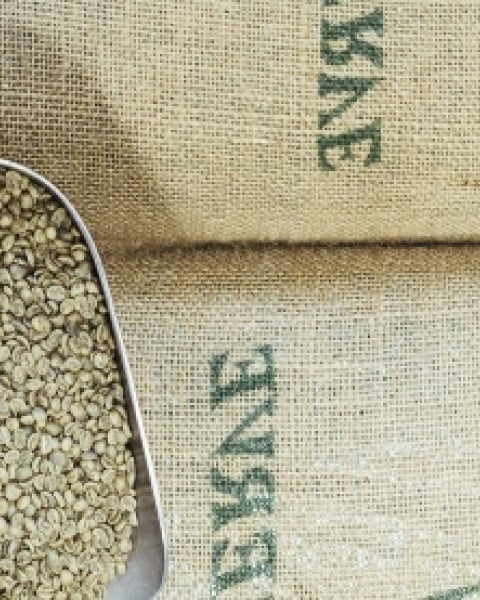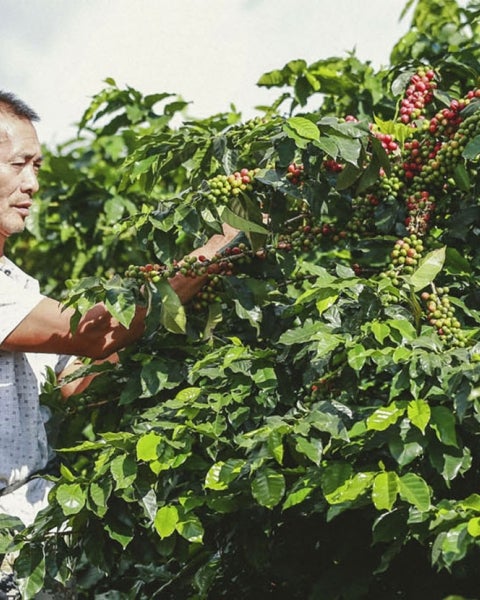Nestlé uses Starbucks trademarks under license. Keurig and K-Cup are trademarks of Keurig Green Mountain, Inc., used with permission. Pike Place is a trademark of The Pike Place Market PDA, used under license. NESPRESSO® is a registered trademark of Société des Produits Nestlé S.A. All other trademarks are the property of their respective owners.
For the days when you just can’t get enough coffee, decaf coffee is the way to go. But what is it? Discover how decaffeinated coffee starts from the bean and finishes in every delicious sip of your cup.
Where Does Caffeine Come From?
Caffeine is one of the most commonly consumed ingredients in the world, traceable in over 60 different kinds of plants, including coffee. In the coffee tree, caffeine is primarily found in the raw seed of the coffee cherry, or fruit of the plant. These raw seeds are called green coffee beans, and once roasted, they create the coffee you enjoy in your daily cup. Learn more about the sourcing and roasting process of green coffee beans.
DIFFERENT COFFEE TREES
There are two types of coffee trees: arabica and robusta. Starbucks only sources beans from arabica trees.
Arabica trees flourish at high elevation, slowing down bean growth, which gives the beans more time to develop that delicious yet refined coffee taste.
How Is Decaf Coffee Made?
The decaffeination process begins with green coffee beans after they are harvested. The green coffee beans naturally have a hard interior and exterior when first picked from the trees. Once picked, there are three primary ways to create decaffeinated coffee: the Direct Contact Method, the SWISS WATER® Process and the Natural Decaffeination Process. Each of these methods provides a safe and effective way to remove 97% or more of the caffeine from the coffee beans, per the high standard put in place by The U.S. Food and Drug Administration.
The Direct Contact Method is the most common way to decaffeinate coffee effectively. During this process, green coffee beans are steamed to open their “pores.” Once the beans are sufficiently softened, a solvent is added to the mass of wet beans. Caffeine molecules then bond with the solvent, leaving the bulk of the other flavor compounds intact. Once the caffeine has been removed, the beans are washed, steamed and roasted at over 400°F to evaporate all liquids used in this process.
The SWISS WATER® Process removes caffeine from green coffee beans by soaking them in warm water to create “flavor-charged water.” That water is then run through an activated charcoal filter that captures the caffeine molecules. No solvents are applied directly to the coffee bean, but the carbon filter essentially filters out the caffeine. Then the coffee beans are soaked in the flavor-charged water to reintroduce the flavors to the coffee.
The Natural Decaffeination Process starts with water-soaked green coffee beans sealed in a stainless-steel tank. Liquid carbon dioxide is forced into the tank at a very high pressure. This process draws out and dissolves the caffeine, leaving larger flavor molecules behind.
Regardless of the process chosen, one step that’s always shared is that the beans are prepared by soaking them in warm water to soften them prior to roasting. This increase of moisture makes the caffeine more easily removable while still preserving the flavor you love in the bean. Once the caffeine is extracted or dissolved, our skilled roasters bring out the aroma, acidity, body and flavor within the decaffeinated beans. Voila! You now have a delicious decaffeinated cup of your favorite Starbucks® coffee.
THE PROCESS
A Peek at Caffeine RemovalAlthough there are many ways to create decaffeinated coffee, each process includes soaking the beans in warm water after they’re harvested. By doing this prior to roasting, the delicious flavors are preserved while also softening the beans to easily remove the caffeine.
Is There Caffeine in Decaf Coffee?
Decaf coffee is a great alternative for when you want delicious, full-bodied coffee flavor at any time of the day. The decaffeination process removes 97% or more of the caffeine, leaving only very little traces in the green coffee beans. The good news: A typical cup of decaf coffee has about 2 milligrams of caffeine, in comparison to a regular coffee that contains about 95 milligrams of caffeine. Meaning, you can enjoy a cup full of the Starbucks® coffee flavor you love any time, with almost no caffeine.




